Integration of Boosted Regression Trees and Cellular Automata—Markov Model to Predict the Land Use Spatial Pattern in Hotan Oasis
Abstract
1. Introduction
2. Study Area
3. Methodology
3.1. Input Data
3.2. BRT-CA-Markov Model
3.2.1. BRT Model
3.2.2. CA-Markov Model
3.2.3. BRT-CA-Markov Model
4. Results
4.1. The Influence of Factors on the Distribution of Land Use
4.2. BRT-CA-Markov Model Validation
4.3. Land Use in 2025 and 2035
5. Discussion
6. Conclusions
Author Contributions
Funding
Conflicts of Interest
References
- Luo, G.P.; Zhou, C.H.; Chen, X.; Li, Y. A methodology of characterizing status and trend of land changes in oases: A case study of Sangong River watershed, Xinjiang, China. J. Environ. Manag. 2008, 88, 775–783. [Google Scholar] [CrossRef]
- Wang, Z.Y.; Xu, D.Y.; Yang, H.; Ding, X.; Li, D.J. Impacts of climate change and human activities on vegetation dynamics in Inner Mongolia, 1981-2010. Prog. Geogr. 2017, 36, 1025–1032. [Google Scholar]
- Aburas, M.M.; Ho, Y.M.; Ramli, M.F.; Ash’aari, Z.H. The simulation and prediction of spatio-temporal urban growth trends using cellular automata models: A review. Int. J. Appl. Earth Obs. 2016, 52, 380–389. [Google Scholar] [CrossRef]
- Zhong, G.M.; Zhang, X.L.; Duan, J.L. Prediction of land use dynamic change in Zhengzhou using Markov process. J. Henan Agric. Univ. 2011, 45, 696–700. [Google Scholar]
- Nouri, J.; Gharagozlou, A.; Arjmandi, R.; Faryadi, S.; Adl, M. Predicting Urban Land Use Changes Using a CA–Markov Model. Arab. J. Sci. Eng. 2014, 39, 5565–5573. [Google Scholar] [CrossRef]
- Gong, W.F.; Yuan, L.; Fan, W.Y.; Stott, P. Analysis and simulation of land use spatial pattern in Harbin prefecture based on trajectories and cellular automata—Markov modelling. Int. J. Appl. Earth Obs. 2015, 34, 207–216. [Google Scholar] [CrossRef]
- Wang, S.Q.; Zheng, X.Q.; Zang, X.B. Accuracy assessments of land use change simulation based on Markov-cellular automata model. Procedia Environ. Sci. 2012, 13, 1238–1245. [Google Scholar] [CrossRef]
- Tian, H.; Liang, X.; Li, X.; Liu, X.P.; Ou, J.P.; Hong, Y.; He, Z.J. Simulating Multiple Land Use Scenarios in China during 2010–2050 Based on System Dynamic Model. Trop. Geol. 2017, 37, 547–561. [Google Scholar]
- Tang, Y.P. The applications of system dynamics model to the comprehensive land use planning of Shaanxi Province. J. Northwest Univ. (Nat. Sci. Ed.) 2012, 42, 1007–1010. [Google Scholar]
- Ou, Z.K.; Tang, N.Q.; Zhang, L.M. Evaluation of intensive land use in development zone based on BP artificial neural network—A case of Fujian Province. J. Fujian Agric. For. Univ. (Nat. Sci. Ed.) 2014, 43, 424–429. [Google Scholar]
- Zhang, X.Y.; Wu, S.D. Explore and Analysis of Regional Land Use Intensity Evaluation Based on BP Neural Network-A Case of Zhangzhou. J. Ningxia Univ. (Nat. Sci. Ed.) 2010, 31, 93–97. [Google Scholar]
- Mondal, B.; Das, D.N.; Bhatta, B. Integrating cellular automata and Markov techniques to generate urban development potential surface: A study on Kolkata agglomeration. Geocarto Int. 2016, 32, 401–419. [Google Scholar] [CrossRef]
- Durmusoglu, Z.O.; Tanriover, A.A. Modelling land use/cover change in Lake Mogan and surroundings using CA-Markov Chain Analysis. J. Environ. Biol. 2017, 38, 981–989. [Google Scholar] [CrossRef]
- Guan, D.; Li, H.; Inohae, T.; Su, W.; Nagaie, T.; Hokao, K. Modeling urban land use change by the integration of cellular automaton and Markov model. Ecol. Model. 2011, 222, 3761–3772. [Google Scholar] [CrossRef]
- Louca, M.; Vogiatzakis, I.N.; Moustakas, A. Modelling the combined effects of land use and climatic changes: Coupling bioclimatic modelling with Markov-chain Cellular Automata in a case study in Cyprus. Ecol. Inform. 2015, 30, 241–249. [Google Scholar] [CrossRef]
- Mondal, P.; Southworth, J. Evaluation of conservation interventions using a cellular automata-Markov model. Forest Ecol. Manag. 2010, 260, 1716–1725. [Google Scholar] [CrossRef]
- Adhikari, S.; Southworth, J. Simulating forest cover changes of Bannerghatta national park based on a CA-Markov Model: A remote sensing approach. Remote Sens. 2012, 4, 3215–3243. [Google Scholar] [CrossRef]
- Sang, L.L.; Zhang, C.; Yang, J.Y.; Zhu, D.H.; Yun, W.J. Simulation of land use spatial pattern of towns and villages based on CA-Markov model. Math. Comput. Model. 2011, 54, 938–943. [Google Scholar] [CrossRef]
- Vaz, E.; Arsanjani, J.J. Predicting Urban Growth of the Greater Toronto Area-Coupling a Markov Cellular Automata with Document Meta-Analysis. J. Environ. Inform. 2015, 25, 71–80. [Google Scholar] [CrossRef]
- Jokar Arsanjani, J.; Helbich, M.; Kainz, W.; Darvishi Boloorani, A. Integration of logistic regression, Markov chain and cellular automata models to simulate urban expansion. Int. J. Appl. Earth Obs. 2013, 21, 265–275. [Google Scholar] [CrossRef]
- Aburas, M.M.; Ho, Y.M.; Ramli, M.F.; Ash’aari, Z.H. Improving the capability of an integrated CA-Markov model to simulate spatio-temporal urban growth trends using an Analytical Hierarchy Process and Frequency Ratio. Int. J. Appl. Earth Obs. 2017, 59, 65–78. [Google Scholar] [CrossRef]
- Yang, X.; Zheng, X.Q.; Lv, L.N. A spatiotemporal model of land use change based on ant colony optimization, Markov chain and cellular automata. Ecol. Model. 2012, 233, 11–19. [Google Scholar] [CrossRef]
- Dou, Y.; Chen, X.; Bao, A.M. Eco-environmental responses of land use and cover change in nearly 40 years in the Hotan River Basin. Arid Land Geol. 2008, 31, 449–455. [Google Scholar]
- Chen, Z.S.; Chen, Y.N.; Li, H.W. Land use/cover change and their driving forces in hotan river basin of xinjiang. J. Desert Res. 2010, 30, 326–333. [Google Scholar]
- Liu, W.; Xu, Y.P.; Huang, Y. Effects of Global Warming on Precipitation and Runoff Volume in Xinjiang. Arid Land Geol. 2005, 28, 597–602. [Google Scholar]
- Wang, S.F.; Jiao, X.Y.; Wang, L.P.; Sang, H.H.; Salahou, M.K.; Maimaitiyiming, A. Assessing climate change impacts on water resources of the Hotan Oasis using SWAT Model, Northwest China. Fresen. Environ. Bull. 2019, 28, 1801–1810. [Google Scholar]
- Shen, B.; Huang, L.M.; Ruan, B.Q.; Luo, G.M. Influence of discharge variation on fluvial process of the Lower Yellow River. J. Hydraul. Eng. 2003, 34, 78–83. [Google Scholar]
- Zhang, X.W.; Shen, B.; Huang, L.M. Study on the Variation Law of the Annual Runoff in Hotan River. J. Nat. Res. 2007, 22, 974–979. [Google Scholar]
- Luo, M.; Meng, F.H.; Liu, T.; Duan, Y.C.; Frankl, A.; Kurban, A.; Maeyer, P.D. Multi–model ensemble approaches to assessment of effects of local climate change on water resources of the hotan river basin in Xinjiang, China. Water 2017, 9, 5840. [Google Scholar] [CrossRef]
- Chen, Y.N. Study on eco-hydrological problems of Tarim River Basin in Xinjiang, 1st ed.; Science Press: Beijing, China, 2010; pp. 0–865. [Google Scholar]
- De’Ath, G. Boosted trees for ecological modeling and prediction. Ecology. 2007, 88, 243–251. [Google Scholar] [CrossRef]
- Elith, J.; Leathwick, J.R.; Hastie, T. A working guide to boosted regression trees. J. Anim Ecol. 2008, 77, 802–813. [Google Scholar] [CrossRef]
- Yin, C.; Liu, M.; Sun, F.Y.; Li, C.L.; Xiang, W.N. Influencing factors of non-point source pollution of watershed based on boosted regression tree algorithm. Chin. J. Appl. Ecol. 2016, 27, 911–919. [Google Scholar]
- Li, C.L.; Liu, M.; Hu, Y.M.; XU, Y.Y.; Sun, F.Y. Driving forces analysis of urban expansion based on boosted regression trees and Logistic regression. Acta Ecol. Sin. 2014, 34, 727–737. [Google Scholar]
- Cai, W.H.; Yang, J.; Lv, Z.H.; Hu, Y.M.; Lv, S.J.; Xing, G.Z.; Zhao, Z.F. Controls of post-fire tree recruitment in Great Xing’an Mountains in Heilongjiang Province. Acta Ecol. Sin. 2012, 32, 3303–3312. [Google Scholar]
- Pontius, R.G.; Schneider, L.C. Land-cover change model validation by an ROC method for the Ipswich watershed, Massachusetts, USA. Agric. Ecosyst. Environ. 2001, 85, 239–248. [Google Scholar] [CrossRef]
- Wang, Y.H.; Yu, Q.; Yue, D.P.; Zhang, Q.B.; Ma, H. Simulation of Land use Based on BRT_DC_Pd Model. Trans. Chin. Soc. Agric. Machinery 2018, 49, 225–234. [Google Scholar]
- Al-sharif, A.A.; Pradhan, B. Monitoring and predicting land use change in Tripoli Metropolitan City using an integrated Markov chain and cellular automata models in GIS. Arab. J. Geosci. 2014, 7, 4291–4301. [Google Scholar] [CrossRef]
- Munthali, M.G.; Mustak, S.; Adeola, A.; Botai, J.; Singh, S.K.; Davis, N. Modelling land use and land cover dynamics of Dedza district of Malawi using hybrid Cellular Automata and Markov model. Remote Sens. Appl.: Soc. Environ. 2020, 17, 100276. [Google Scholar] [CrossRef]
- Derya, O. Urban Growth Simulation of Atakum (Samsun, Turkey) Using Cellular Automata-Markov Chain and Multi-Layer, Perceptron-Markov Chain Models. Remote Sens. 2015, 7, 5918–5950. [Google Scholar]
- Kityuttachai, K.; Tripathi, N.K.; Tipdecho, T.; Shrestha, R. CA-Markov Analysis of Constrained Coastal Urban, Growth Modeling: Hua Hin Seaside City, Thailand. Sustainability 2013, 5, 1480–1500. [Google Scholar] [CrossRef]
- Ozturk, D. Modelling spatial changes in coastal areas of Samsun (Turkey) using a Cellular Automata-Markov chain method. Teh. Vjesn. 2017, 241, 99–107. [Google Scholar]
- Luo, G.P.; Amuti, T.; Zhu, L.; Mambetov, B.T.; Maisupova, B.; Zhang, C. Dynamics of landscape patterns in an inland river delta of Central Asia based on a cellular automata-Markov model. Reg. Environ. Chang. 2015, 15, 277–289. [Google Scholar] [CrossRef]
- Donker, D.K.; Hasman, A.; Geijn, H.P.V. Interpretation of low kappa values. Int. J. Biomed Comput. 1993, 33, 55–64. [Google Scholar] [CrossRef]
- Yang, Y.Y.; Zhang, S.W.; Yang, J.C.; Xing, X.S.; Wang, D.Y. Using a Cellular Automata-Markov Model to Reconstruct Spatial Land-Use Patterns in Zhenlai County, Northeast China. Energies 2015, 8, 3882–3902. [Google Scholar] [CrossRef]
- Kamusoko, C.; Aniya, M.; Adi, B.; Manjoro, M. Rural sustainability under threat in Zimbabwe–simulation of future land use/cover changes in the Bindura district based on the Markov-cellular automata model. Appl. Geogr. 2009, 29, 435–447. [Google Scholar] [CrossRef]
- Ye, L.; Ranst, E.V. Production scenarios and the effect of soil degradation on long-term food security in China. Global Environ. Chang. 2009, 19, 464–481. [Google Scholar] [CrossRef]
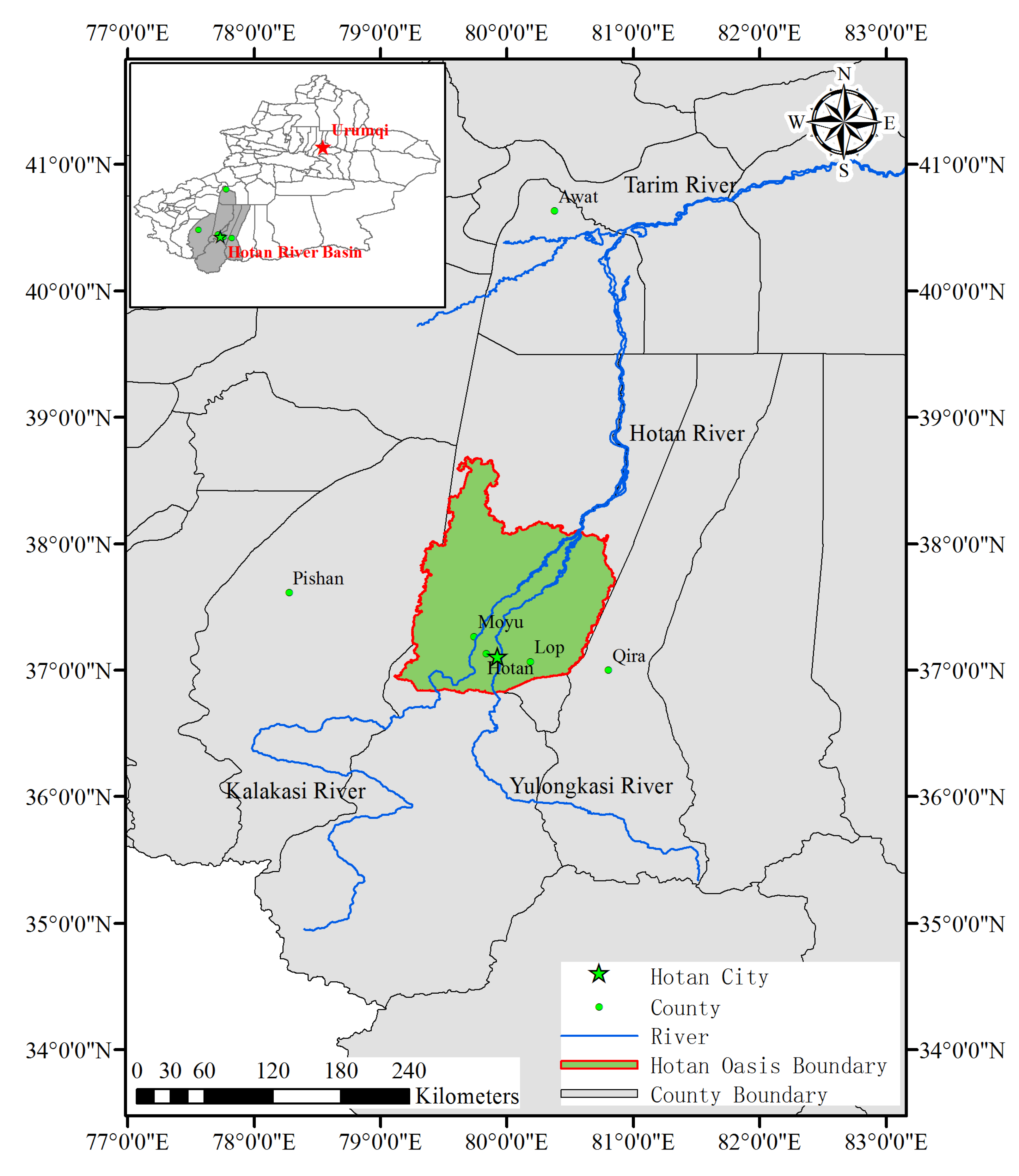
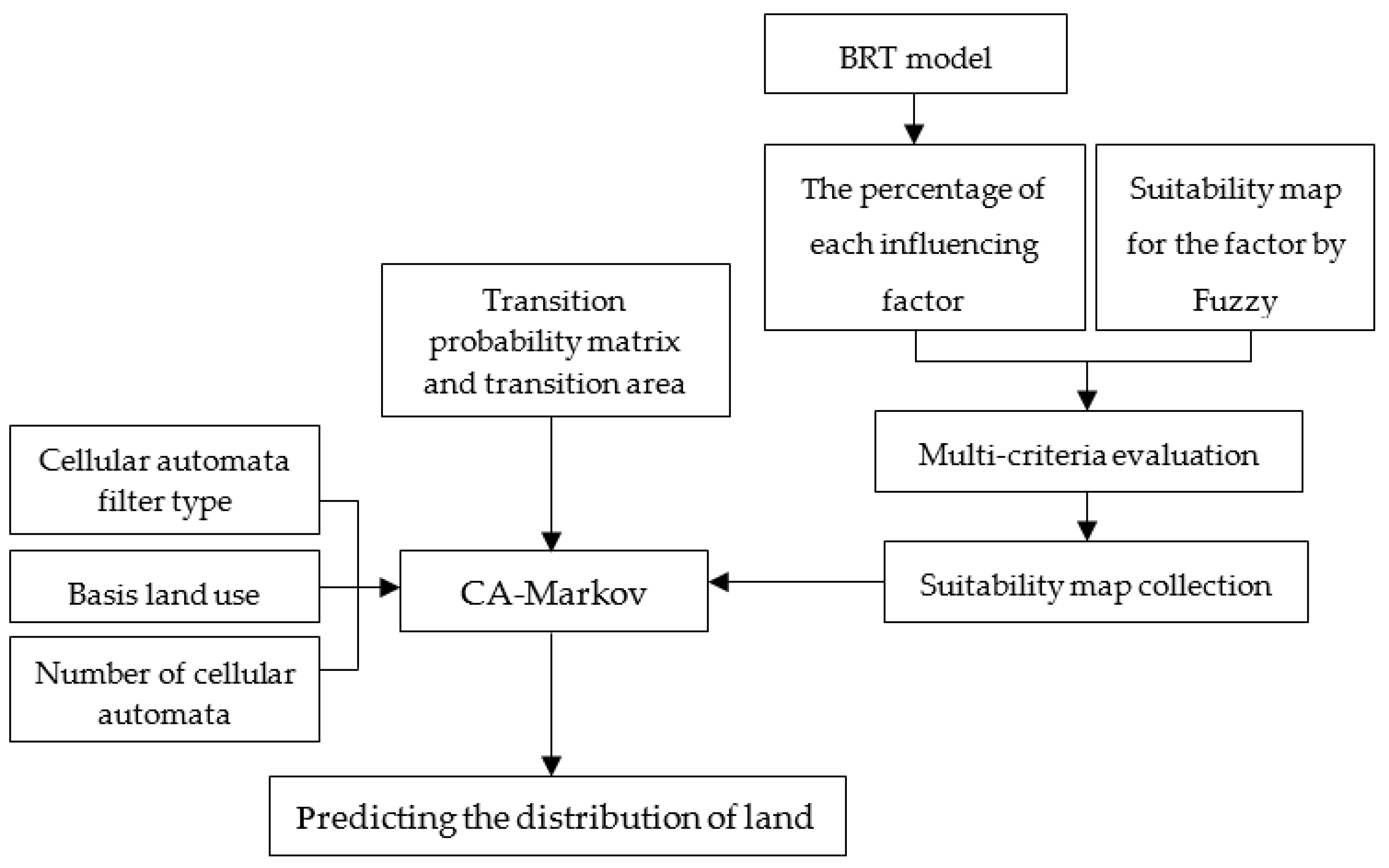
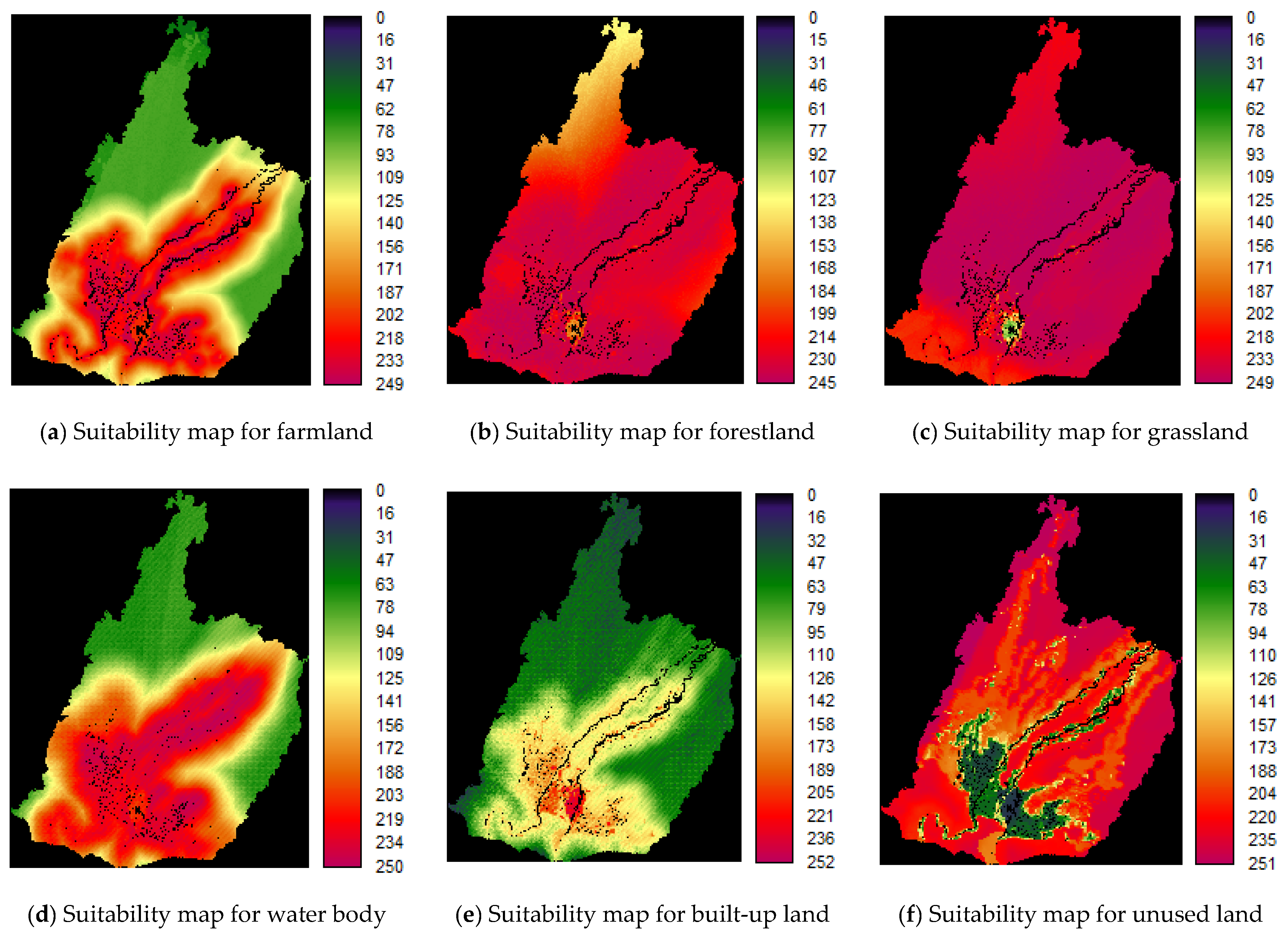
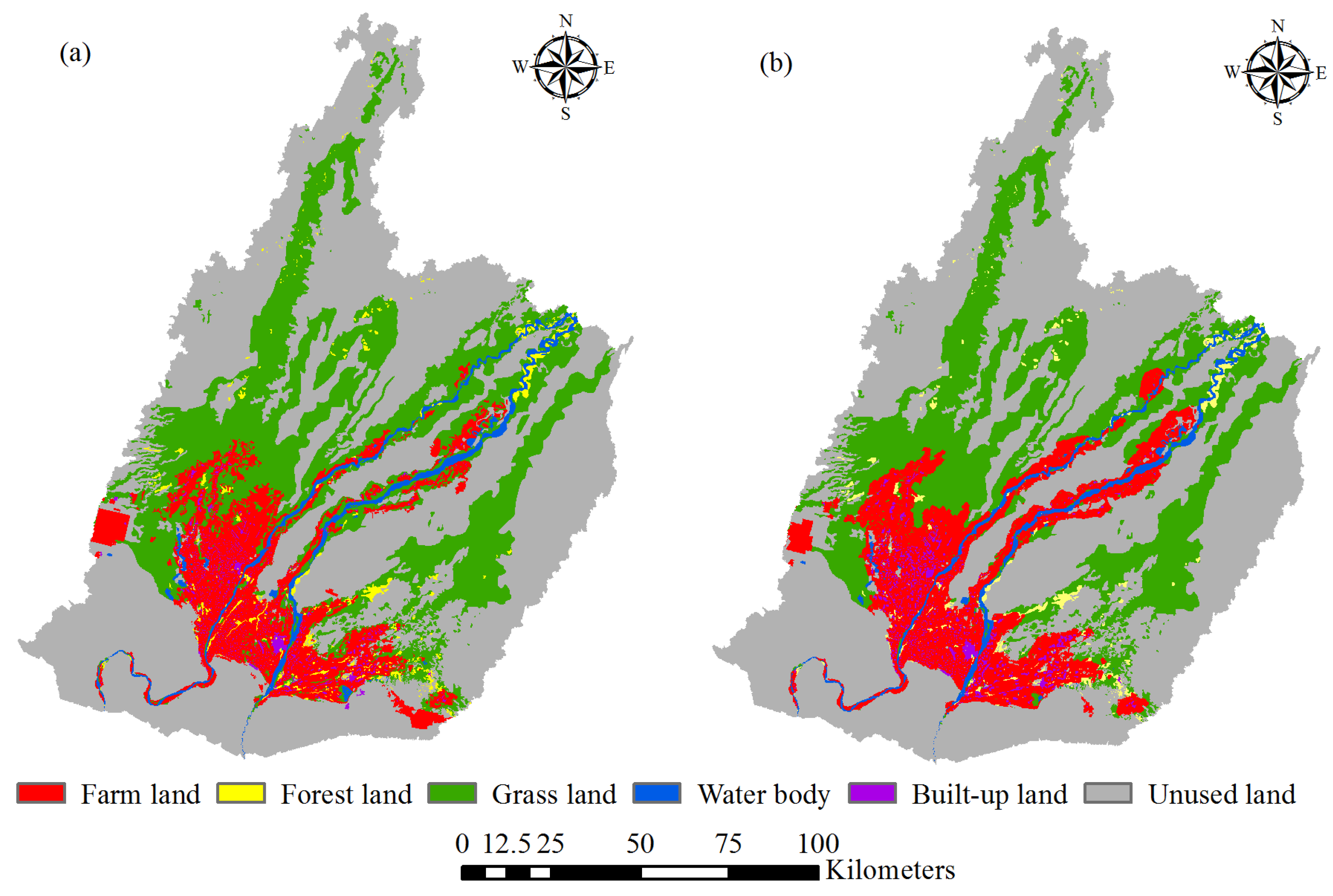
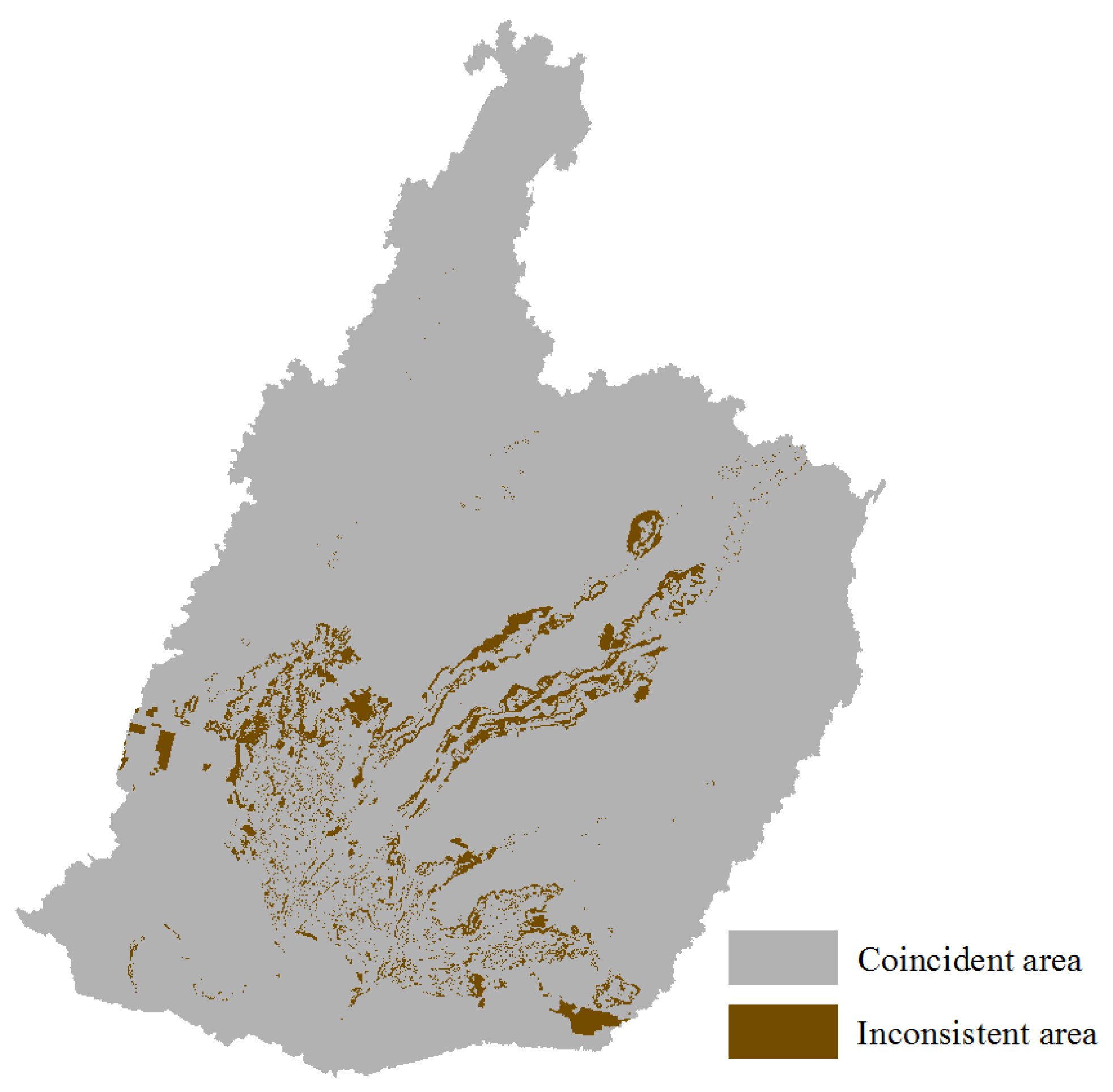

| Factors | Factors Attribute | Unit | Scale |
|---|---|---|---|
| Elevation | Natural Factors | m | 1095.00–2858.00 |
| Slope | degree | 0–76.32 | |
| Annual Precipitation | mm | 52.67–233.85 | |
| Annual Temperature | ℃ | 5.43–13.52 | |
| Groundwater Depth | m | 0.22–0.43 | |
| Population Density | Human Factors | person/km2 | 2.09–3800.25 |
| Gross domestic Product Density | yuan/km2 | 0.2–5833.57 | |
| Distance to Water Body | km | 0–105.95 | |
| Distance to Roads | km | 0–82.09 | |
| Distance to the Village Centers | km | 0–120.62 |
| Date | Farmland | Forestland | Grassland | Water Body | Built-Up Land | Unused Land |
|---|---|---|---|---|---|---|
| Training Data | 0.984 | 0.973 | 0.990 | 0.998 | 0.992 | 0.996 |
| Validation Data | 0.984 | 0.970 | 0.986 | 0.998 | 0.992 | 0.994 |
| Factors | Farmland | Forestland | Grassland | Water Body | Built-Up Land | Unused Land |
|---|---|---|---|---|---|---|
| Elevation | 1.6 | 6.4 | 15.3 | 8.6 | 4.1 | 3.1 |
| Slope | 1.1 | 3.0 | 1.2 | 3.4 | 7.7 | 0.7 |
| Annual Precipitation | 1.6 | 6.0 | 2.8 | 6.4 | 6.9 | 1.6 |
| Annual Temperature | 1.9 | 5.8 | 3.4 | 5.3 | 7.6 | 2.3 |
| Groundwater DEPTH | 2.1 | 5.5 | 4.0 | 9.8 | 5.7 | 3.4 |
| Population density | 4.1 | 8.6 | 34.4 | 10.8 | 11.1 | 20.4 |
| Gross Domestic Product Density | 31.0 | 20.3 | 28.9 | 7.3 | 27.1 | 58.7 |
| Distance to Water Body | 2.9 | 5.1 | 3.6 | 26.7 | 8.2 | 7.5 |
| Distance to Roads | 17.6 | 28.4 | 3.2 | 16.0 | 6.4 | 0.8 |
| Distance to the Village Centers | 36.1 | 10.8 | 3.2 | 5.7 | 15.2 | 1.5 |
| Date | Farmland | Forestland | Grassland | Water Body | Built-Up Land | Unused Land |
|---|---|---|---|---|---|---|
| Actual Pixels | 2,255,384 | 248,961 | 5,380,486 | 438,675 | 191,779 | 11,859,811 |
| Simulation Pixels | 2,638,444 | 251275 | 4,796,339 | 417,759 | 278,028 | 11,993,251 |
| Percentage Error | 15.52 | 15.46 | 13.41 | 7.34 | 6.24 | 0.01 |
| Kc | 0.89 | |||||
| Land Classification | 2015 | 2025 | Change of 2015 to 2025 | 2035 | Change of 2015 to 2035 |
|---|---|---|---|---|---|
| Farmland | 2029.85 | 2175.65 | 145.80 | 2321.46 | 291.61 |
| Forestland | 224.06 | 220.21 | −3.85 | 216.36 | −7.70 |
| Grassland | 4842.44 | 4751.00 | −91.44 | 4659.58 | −182.86 |
| Water Body | 394.81 | 399.65 | 4.84 | 404.46 | 9.65 |
| Built-Up Land | 172.60 | 176.82 | 4.22 | 181.03 | 8.43 |
| Unused Land | 10,673.83 | 10,614.26 | −59.57 | 10,554.71 | −119.12 |
© 2020 by the authors. Licensee MDPI, Basel, Switzerland. This article is an open access article distributed under the terms and conditions of the Creative Commons Attribution (CC BY) license (http://creativecommons.org/licenses/by/4.0/).
Share and Cite
Wang, S.; Jiao, X.; Wang, L.; Gong, A.; Sang, H.; Salahou, M.K.; Zhang, L. Integration of Boosted Regression Trees and Cellular Automata—Markov Model to Predict the Land Use Spatial Pattern in Hotan Oasis. Sustainability 2020, 12, 1396. https://doi.org/10.3390/su12041396
Wang S, Jiao X, Wang L, Gong A, Sang H, Salahou MK, Zhang L. Integration of Boosted Regression Trees and Cellular Automata—Markov Model to Predict the Land Use Spatial Pattern in Hotan Oasis. Sustainability. 2020; 12(4):1396. https://doi.org/10.3390/su12041396
Chicago/Turabian StyleWang, Shufang, Xiyun Jiao, Liping Wang, Aimin Gong, Honghui Sang, Mohamed Khaled Salahou, and Liudong Zhang. 2020. "Integration of Boosted Regression Trees and Cellular Automata—Markov Model to Predict the Land Use Spatial Pattern in Hotan Oasis" Sustainability 12, no. 4: 1396. https://doi.org/10.3390/su12041396
APA StyleWang, S., Jiao, X., Wang, L., Gong, A., Sang, H., Salahou, M. K., & Zhang, L. (2020). Integration of Boosted Regression Trees and Cellular Automata—Markov Model to Predict the Land Use Spatial Pattern in Hotan Oasis. Sustainability, 12(4), 1396. https://doi.org/10.3390/su12041396




